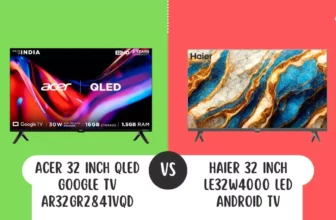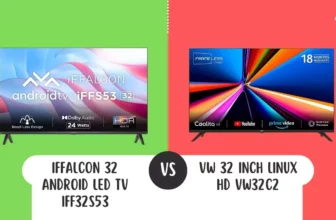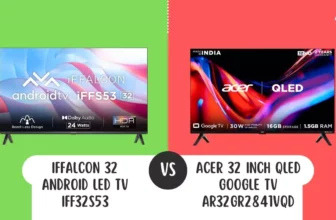
Are you going to buy or consider the new premium-class TV set, or are you just curious about these two technologies? In the ever-evolving world of TV technology, two giants have emerged as the frontrunners in delivering unprecedented visual experiences: OLED TV (Organic Light-Emitting Diodes) and QLED TV (Quantum Dot light-emitting diode). Both promise unparalleled contrast, dazzling brightness, and a spectrum of colors previously unattainable.
Yet each technology has its own unique mechanism with distinct advantages, and both offer pros and cons. The debate between OLED and QLED focuses on differences in display performance, longevity, and how they cater to the discerning viewer’s eye. As we delve into the intricate world of these advanced TV technologies, let’s explore how the future of television is brighter, bolder, and more beautiful than ever.
OLED TV vs QLED TV: What are the differences?
Both technologies are not exactly new, but they remain the latest as of now, and both represent premium TV technologies. OLED and QLED are types of display technologies, not resolutions. Let’s delve into a detailed comparison of their major components.
| Aspect | OLED TV | QLED TV |
|---|---|---|
| How They Light Up | Each pixel produces its own light (no need for backlight) | Uses LED backlighting and quantum dots to enhance color and brightness |
| Black Levels | Achieves perfect blacks; individual pixels can be turned off | Good black levels, but not as perfect as OLED due to the always-on backlight |
| Brightness | Bright, but usually not as bright as QLED | Very bright, suitable for well-lit rooms |
| Lifespan and Burn-In | Lower input lag and faster response times; true black enhances the gaming | No burn-in issues; generally longer lifespan |
| Thickness and Design | Very thin with sleek designs | A bit thicker due to backlighting |
| Price | Typically more expensive | Often more affordable, especially in larger sizes |
| Gaming | Lower input lag and faster response times; true black enhances the gaming | Supports variable refresh rates (like FreeSync) for smoother gaming; brightness enhances colorful games |
| TV Brands | Sony, LG, MI, and Samsung | Samsung, Acer, OnePlus, MI, VU, Iffalcon, Hisense, TCL, and VU are major brands for QLED TVs in India |
- How They Light Up:
- OLED: Each tiny pixel produces its own light. There is no need for a backlight.
- QLED: Uses LED backlighting and quantum dots to enhance color and brightness.
- Black Levels:
- OLED: This can achieve perfect blacks because individual pixels can turn off completely.
- QLED: Good black levels, but not as perfect as OLED since the backlight is always on.
- Brightness:
- OLED: Bright, but QLED can usually go brighter.
- QLED: Very bright, which is great for well-lit rooms.
- Lifespan and Burn-In:
- OLED: This can suffer from “burn-in” if static images stay on the screen for too long, but it’s a rare issue for average users.
- QLED: No burn-in issues and generally a longer lifespan.
- Thickness and Design:
- OLED: Very thin and often has sleeker designs.
- QLED: A bit thicker due to the backlighting.
- Price:
- OLED: Typically more expensive.
- QLED: Often more affordable, especially at larger sizes.
- Gaming:
- OLED: Offers lower input lag and faster response times, making it great for fast-paced games. True black can also enhance the gaming experience in darker game scenes.
- QLED: It often comes with technology that supports variable refresh rates (like FreeSync), which can provide a smoother gaming experience. The brightness can make colorful games pop.
8. TV Brands:
- OLED: Sony, LG, MI, and Samsung are the major brands in India that make OLED TVs.
- QLED: Samsung, Acer, OnePlus, MI, VU, Iffalcon, Hisense, TCL, and VU are the major TV brands that make QLED TVs in India.
In summary, OLED TVs offer superior black levels and thinner designs, making them great for those who prioritize picture quality and aesthetics. On the other hand, QLED TVs excel in brightness and are generally more affordable, appealing to those seeking vibrant visuals in well-lit environments. The choice between the two largely depends on individual preferences, usage scenarios, and budget considerations.
Is QLED faster than OLED?
For a normal user, both are the same, only the brightness level and contrast of the display is easily detected by a normal user. But when we talk about “faster” in the context of displays, we often refer to the response time and refresh rates of the screen. Here’s a comparison of QLED and OLED in this aspect:
OLED:
- Response Time: OLEDs typically have very fast response times, often less than 1 millisecond. This means they can change the colors of individual pixels almost instantly.
- Refresh Rates: Modern OLEDs can have high refresh rates, but the exact rate can vary depending on the model and manufacturer.
QLED:
- Response Time: QLEDs generally have good response times, but they are typically not as fast as OLEDs.
- Refresh Rates: Like OLEDs, QLEDs can also come with high refresh rates. The exact rate depends on the TV model and brand.
So, is QLED faster than OLED? In terms of response time, OLED is naturally faster, making it a bit better for fast-paced content like some video games or sports. However, both technologies can support high refresh rates suitable for most viewing purposes, as we discussed, such as gaming.
It’s also worth noting that while response time is important for minimizing motion blur, other factors, such as input lag, are more critical for gaming experiences. Always consider your primary use for the TV when making a decision.
OLED vs QLED: Which Type of TV Wins?
QLED TVs shine brightly, often making them an excellent choice for rooms with lots of ambient light. These TVs, primarily offered by brands like Samsung, TCL, and Hisense, often come at a more affordable price point. The vibrant colors and enhanced brightness are some of their standout features.
On the other hand, OLED TVs, represented by brands like LG, Sony, and Panasonic, are known for their ability to produce perfect blacks. This is because each pixel can light up (or turn off) individually. As a result, they can achieve true darkness, which can be particularly immersive for movie nights. Additionally, the slim design of OLEDs makes them an attractive option for those who prioritize aesthetics.
So, which is best? It truly depends on what you’re looking for. If a brighter screen that performs well in daylight and potential cost savings are on your list, QLED might be your pick. However, if you’re after perfect blacks and a sleeker design, OLED could be the way to go.
But if you want to know our personal view, as an Indian, I would say that if you’re seeking the best picture quality at a more affordable price range, then QLED would be perfect. However, if you don’t want to compromise on quality, I would definitely suggest an OLED TV. I personally prefer OLED for all forms of entertainment, be it movies, gaming, or shows. In this regard, OLED is the winner, so I’d recommend considering it for purchase.
OLED vs QLED: Pros and Cons
OLED and QLED technology is superior when compared to other technologies. Both come with significant technological advancements, and these pros and cons are in direct comparison to each other. So, let’s examine the advantages and disadvantages of both TVs.
OLED TVs
Pros:
- Perfect Blacks: Individual pixels can turn off completely, resulting in true black.
- Thin Design: OLED panels are inherently thin, making for sleeker TV designs.
- Wide Viewing Angles: Colors and contrast stay consistent even when viewed from the side.
- Fast Response Time: Ideal for action-packed movies and gaming.
Cons:
- Price: Typically more expensive.
- Brightness: Not as bright as QLED TVs, which can be an issue in very well-lit rooms.
- Burn-In: Rare but potential risk of static images “burning in” but normal users may be not able to find it.
QLED TVs
Pros:
- Brightness: Capable of achieving very high levels of brightness.
- Color: Quantum dots offer vibrant and more varied colors.
- No Burn-In: Doesn’t suffer from the potential burn-in issue seen in OLEDs.
- More Affordable: Generally less expensive than OLEDs, especially at larger sizes.
Cons:
- Black Levels: Can’t achieve the perfect blacks of OLED due to backlighting.
- Viewing Angles: Colors and contrast might shift when viewed from extreme angles.
- Thickness: Typically thicker than OLED TVs due to the backlighting.
OLED vs. QLED: Which is better for you?
Both TVs deliver outstanding picture quality. While we’ve covered many aspects above, let’s pinpoint which is ideal for specific uses.
If you prioritize brightness, especially with ambient lighting in your room, then QLED is the better fit. Its high brightness levels outshine OLED. However, for viewing in darker rooms or areas that mimic a theater setting, OLED shines due to its exceptional contrast, rendering true whites and perfect blacks.
For gamers, OLED offers a faster response time and reduced input lag. However, if you game for extended periods, be cautious of the rare yet possible burn-in. In contrast, certain QLED models stand out for gaming, boasting features like variable refresh rates, and they don’t run the risk of burn-in.
In terms of design, if you’re after a sleek, ultra-thin TV that seamlessly blends with the wall, OLED is unrivaled. QLED TVs, while generally bulkier, are sturdy and come in a wider variety of sizes. One downside of OLED TVs is the potential for burn-in, which might impact their lifespan. QLEDs, free from burn-in concerns, tend to last longer.
Lastly, on the pricing front, if you’re seeking a cost-effective option, especially in larger sizes, QLED typically offers more value. But if you’re prepared to pay a premium for unmatched contrast and color precision, the extra investment in OLED might just be worth it.
Is Sony’s OLED Superior to Samsung’s QLED?
Sony is considered the most premium TV brand in India. People view it as a guarantee of a long-term investment, especially for its TV sets. While Samsung offers an affordable price range with long-lasting products and TVs. Sony has been offering smart TVs for over a decade, and its products are consistently top-notch. Whether it’s build quality, design, or display, Sony TVs provide one of the best experiences we’ve ever encountered.
When determining the superiority between Sony’s OLED and Samsung’s QLED, it’s crucial to note that each brings its own strengths and potential drawbacks, making the “best” choice subjective to individual needs and preferences.
Sony’s OLED is renowned for its perfect blacks, achieved by turning off individual pixels, resulting in stunning contrast ratios and vibrant colors. Additionally, the wide viewing angles on OLEDs ensure a consistent picture even from off-center perspectives. On the other hand, Samsung’s QLED excels in delivering remarkably bright images, courtesy of its quantum dot technology, making it ideal for rooms drenched in ambient light. While OLEDs provide impressive brightness, they often don’t match the luminosity of top-tier QLEDs.
However, a notable concern with OLEDs, including Sony’s, is the potential for burn-in over prolonged periods, an issue absent in QLEDs. In terms of pricing, OLEDs tend to be more expensive, especially as screen size increases, whereas QLEDs offer a more cost-friendly alternative for larger displays. Design-wise, OLEDs boast a slim profile, while QLEDs, although thin, offer premium builds without being as feeble.
Regarding software, Sony’s OLEDs leverage Android TV, known for its vast app selection, while Samsung’s QLED TVs operate on the user-centric Tizen OS. In essence, both Sony’s OLED and Samsung’s QLED represent the pinnacle of modern TV tech. The decision between the two hinges on specific requirements, such as brightness needs, budget constraints, and design preferences. Both, however, promise an immersive viewing experience.
What is Display Burn-In and How Can You Prevent It?
Burn-in happens when a picture stays on the screen too long and gets “stuck” there. Think of it like a ghost image that you can’t get rid of. OLED TVs, the ones that use special light-up materials for each tiny dot on the screen, get this problem more often. Older plasma TVs had this problem too. To keep this from happening, try not to leave the same picture on for a really long time. Use features like screen savers, and don’t keep the screen too bright. Even though there’s a chance for burn-in with some TVs if you watch different things and change the channel or app now and then, you probably won’t see it.








